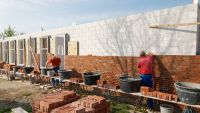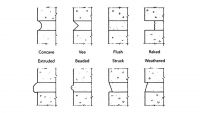Brick/Mortar Compatibility Research Continues
Many model building codes require that brick with an initial rate of absorption (IRA) greater than 30 gm/min/30 sq. in. be wetted before laying. This is to prevent the mortar from drying too rapidly. The loss of water from the mortar may result in incomplete hydration of the cement. This is thought to result in lower flexural bond strength and walls with greater water penetration.
The building codes do not differentiate between mortar cementitious materials nor mortar type. Proper wetting of the brick is difficult to achieve and is often ignored by the mason. There is no accepted method of wetting the brick.
The Brick Institute of America (BIA), the Portland Cement Association (PCA), and the National Lime Association (NLA) have joined to evaluate the performance of high IRA brick with a variety of mortar cementitious materials and mortar types. This investigation is similar to a study completed in 1995 on brick with an IRA of 5 or less. The objective of both programs is to identify those mortar materials and types which are most compatible with brick of a given IRA.
Brick selected for this study will be all 100% solid units with wire cut bed surfaces. Mortars will be mixed by proportions using cementitious materials predominant in the Chicago area. Mortar water content will be set by the mason. Tests will be run to determine typical physical properties of all materials.
Flexural unit strength will be evaluated using ASTM C1072. The combinations of materials shown in Table I will be tested. The 45 - 50 gm brick will be laid in both dry and wetted conditions.
The results of the flexural bond tests will be used to select unit/mortar combinations for ASTM E514 water penetration tests. The combination of brick and mortar types that give the highest and lowest bond strength values will be tested.
The brick with the 15 - 20 gm IRA will serve as a basis of comparison. It is the same brick used in the low IRA brick tests run earlier. Thus, this series of tests complements the earlier research.
Table I. Bond Wrench Matrix
| Unit IRA gm per min per 30 sq. in. | Cementitious Material and Mortar Type | ||||||
| Portland Cement/Lime | Mortar Cement | Masonry Cement | |||||
| S | N | O | S | N | S | N | |
| 15 - 20 | X | X | X | X | X | ||
| 25 - 30 | X | X | X | X | X | X | |
| 45 - 50 | X | X | X | X | X | X | X |
About the Author
J. Gregg Borchelt, P.E. is the President and Chief Executive Officer and Vice President of Engineering and Research for the Brick Industry Association (BIA). He was in charge of technical information for BIA; Gregg also chairs ASTM Subcommittee C 15.02 on Brick and Clay Tile.


















